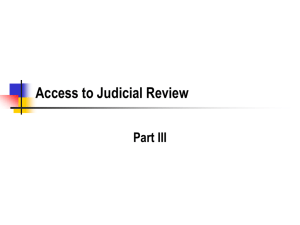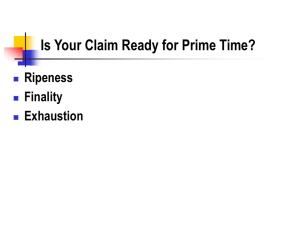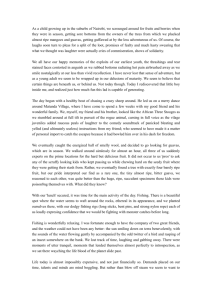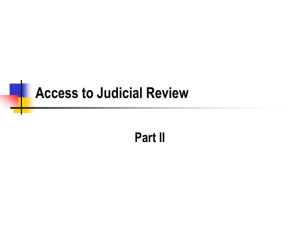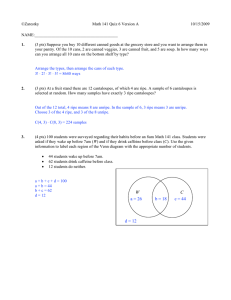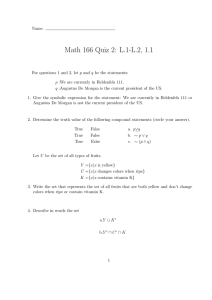Module 24 - Ripeness and Wrap-up
advertisement
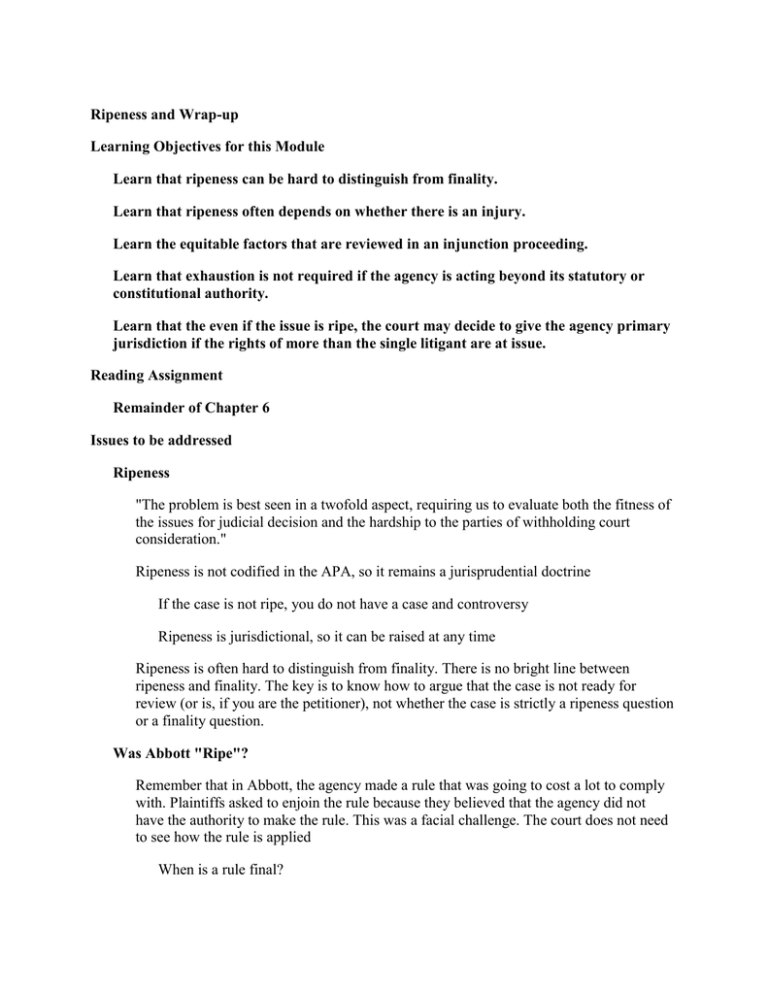
Ripeness and Wrap-up Learning Objectives for this Module Learn that ripeness can be hard to distinguish from finality. Learn that ripeness often depends on whether there is an injury. Learn the equitable factors that are reviewed in an injunction proceeding. Learn that exhaustion is not required if the agency is acting beyond its statutory or constitutional authority. Learn that the even if the issue is ripe, the court may decide to give the agency primary jurisdiction if the rights of more than the single litigant are at issue. Reading Assignment Remainder of Chapter 6 Issues to be addressed Ripeness "The problem is best seen in a twofold aspect, requiring us to evaluate both the fitness of the issues for judicial decision and the hardship to the parties of withholding court consideration." Ripeness is not codified in the APA, so it remains a jurisprudential doctrine If the case is not ripe, you do not have a case and controversy Ripeness is jurisdictional, so it can be raised at any time Ripeness is often hard to distinguish from finality. There is no bright line between ripeness and finality. The key is to know how to argue that the case is not ready for review (or is, if you are the petitioner), not whether the case is strictly a ripeness question or a finality question. Was Abbott "Ripe"? Remember that in Abbott, the agency made a rule that was going to cost a lot to comply with. Plaintiffs asked to enjoin the rule because they believed that the agency did not have the authority to make the rule. This was a facial challenge. The court does not need to see how the rule is applied When is a rule final? Was this rule final? Why did the agency argue that the plaintiffs would not be harmed by delaying the review until someone violated the rule and was sanctioned? Why would defendants argue that they could not risk enforcement and thus would have to change the labels before finding out of the agency had the legal authority to make the rule? Why might the court be reticent to grant an injunction to stop the FRA from regulating a dangerous drug? Prevents important health and safety measures Enmeshes the court in agency policy making Do you think the court might have ruled differently if the dispute was over including a risk on the label, rather than just the generic name of the drug? What are the equitable factors that are balanced in all injunction reviews? What is the risk to the public of granting the injunction? What are the special factors in the drug business? What is the risk of waiting for enforcement? (The usual formulation is whether there will be irremediable harm.) Does the court have enough information to determine the issue? Abbott Rule Where the legal issue presented is fit for judicial resolution, and where a regulation requires an immediate and significant change in the plaintiffs’ conduct of their affairs with serious penalties attached to noncompliance, access to the courts under the [APA] must be permitted, absent a statutory bar or some other unusual circumstance. . . Toilet Goods Assn. v. Gardner, 387 U.S. 158 (1967) Companion case to Abbott FDA promulgated a rule allowing them to inspect toilet good manufacturers to assure compliance with FDA regulations How is a rule allowing inspections different from the rule in Abbott? Does it require the manufacturers to change anything? When can they challenge the admission of the inspector? How are the equities different from Abbott? Example: EPA Smoke Spotters The “credible evidence” rule allowed visual observation of smoke from a smokestack to be used as evidence that a person was violating its Clean Air Act requirements Plaintiffs contest the action, saying it was beyond agency authority Is this more like Toilet Goods or Abbott Labs? Do plaintiffs have to change their behavior? Was the Dispute Ripe in National Automatic Laundry? The court found that the dispute in National Automatic Laundry was ripe because the opinion included detailed factual hypotheticals on the application of the doctrine in different situations This gave the court the necessary factual information to review the application. Without this detail, the court would have required the plaintiff to wait for enforcement so there would be facts to evaluate. Or the court would have said that it was an interpretative rule and not a final action that changed the plaintiffs rights. What about Compliance Orders? An order to a specific party to obey the law Based on the agency's view that the party is not in compliance with the law Not self-enforcing - the agency must bring a separate enforcement action to force compliance What can the plaintiff do if it believes that it is not violating the law? Does this look like Standard Oil? Is this an appealable final action? Is it ripe? Sackett v. U.S. EPA, 132 S. Ct. 1367 (2012) (Decided since the book was published.) Are EPA Clean Water Act compliance orders final, appealable orders? These differ from the usual compliance order in that the EPA starts the penalty clock from the issuance of the compliance order. Thus there is an ever increasing penalty for delay in complying. You cannot get review until enforcement, but the penalty keeps going up if you lose. How would this change your analysis from the ordinary compliance order? The court found that these were final, appealable orders because they had changed the plaintiffs legal rights. What if You Benefit from a Policy that is Being Changed? FDA regulates unavoidable contamination in foods These are impossible to completely remove The agency issues allowable (action) levels This is a safe harbor, it is not necessarily the safety limit that would trigger sanctions if exceeded Whose Claim is Ripe? You represent consumers who believe that the new (higher) action levels are dangerous Is the action ripe as to your claim? Can it get riper as to the consumers? What about manufacturers who think the level is too low? How are they different from consumers? What new info might the court get by waiting until enforcement? What if the Agency Changes a Permit Process to Your Detriment? The NRC says it is loosening up the permit process for dumping low level waste Is this ripe? What has to happen before any waste is dumped under this rule? What if the forest service loosens up the permit process for clear cutting, but there must be a timber sale with public input before the timber can be cut? We saw this case earlier as a question of injury. When Can You Go to Court Without Exhausting Agency Actions? The agency action is unconstitutional or exceeds the agency's legal authority Rulemaking - Facial Challenge How does this differ from a challenge that the record is not adequate? You have to convince the court that the rule does not have a legal application You have to convince the court that your client will suffer significant harm if it must wait for enforcement If you fail, then you have to wait until the agency acts against your client Agency enforcement actions let you go for an injunction or other attack on the agency authority Impossibility of Agency Remedy The agency does not offer the remedy you seek You want money damages and the agency remedies only offer that the agency will stop enforcement actions Congress can require you to still exhaust your agency remedy The agency is biased against your client Just showing that you are going to lose is not enough Remember from previous chapters how hard this is to prove. Primary Jurisdiction This is related to "Committed to agency discretion" In these disputes there is an issue which meets the standard for judicial review The primary jurisdiction question is whether the courts should let the agency resolve the problem first This is important when national uniformity is important, such as automobile emissions standards The court gives the agency the chance to rule for the country before hearing an individual dispute Often resolves the dispute, so no judicial remedy is necessary Evaluation Questions Ripeness What is ripeness? How is ripeness used in the analysis of whether there is an injury that satisfies standing requirements? Why is a final action required before a case can be ripe? Thinking about Abbott Labs with Toilet Products, how do you analyze whether a case with a final agency action is ripe? What are the equitable factors that you have to show to get pre-enforcement review? What is the key legal issue the court will be concerned with when deciding whether a case is ripe for pre-enforcement review? Thinking about the FDA food action level example, why is the action ripe as to consumers, but not ripe as to food processors? Why is getting an injunction critical to pre-enforcement review? What are the factors the court should consider in reviewing a request for an injunction in a pre-enforcement challenge case? What are possible agency arguments against granting an injunction? How do you analyze whether compliance orders are ripe? (assume that the underlying law or regulation is well accepted). What did the court look to in Sackett v. EPA to determine that the order was ripe? As counsel to an agency, what would you tell them about how to structure compliance orders after Sackett to avoid the courts finding them ripe for review. Primary Jurisdiction When does the primary jurisdiction doctrine come up? How do the primary jurisdiction doctrine and exhaustion doctrine differ? What factors do you argue to the court when there is a primary jurisdiction question?
